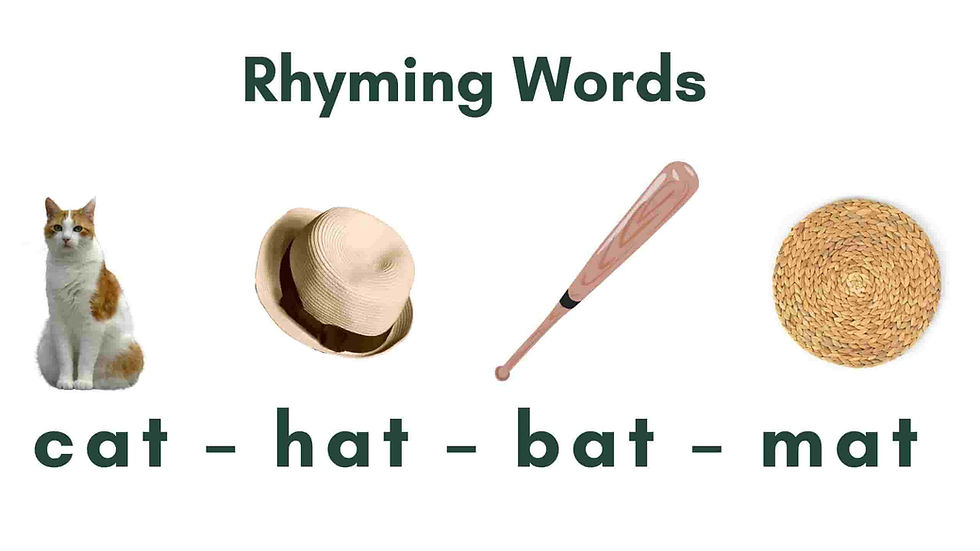Rhyming Books: An Educational Tool for Preschool and Kindergarten
- Aria Dana

- Aug 13
- 10 min read
Updated: Sep 16

Have you ever wondered why rhyming books are such a big part of preschool and kindergarten education? These playful stories do more than entertain — they help children develop phonemic awareness, the ability to recognize sound patterns in language. This skill is one of the most important steps in early childhood literacy and lays the foundation for becoming a confident reader.
Through rhymes, little learners expand vocabulary, strengthen comprehension, and build a love for words. In this guide, we’ll explore the best rhyming books for preschool and kindergarten, along with games, activities, and workbooks that make reading both joyful and educational.
Looking for the best rhyming books for preschool and kindergarten? Check out our top picks below. ⬇️
Table of Contents
What is a rhyming book?
A rhyming book is a type of children’s book that uses repeated sound patterns—especially words that end with the same or similar sounds—to create rhythm and musicality in the text.
Feature rhyming linguistic structures such as end-of-line rhymes, sound similarities, word repetitions, and playful language, making the stories engaging and memorable for young children [2].
Commonly used with preschool and kindergarten children to support language development, phonological awareness, and early literacy skills by helping them recognize and predict sound patterns in words [2].
Why Are Rhyming Books Important for Language Development in Preschool and Kindergarten?
Rhyming books promote phonemic awareness—the ability to recognize and manipulate sounds in words—which is a foundational skill for learning to read. Repeated exposure to rhymes helps children identify sound patterns, supporting their ability to decode new words later on [8, 9, 12, 14, 20]. Rhyming stories also make language playful and memorable, increasing engagement and motivation for young learners [2, 3,4, 6, 19].
What are the benefits?
Vocabulary Expansion: Nursery rhymes and rhyming books significantly improve vocabulary acquisition, including both basic and more complex words, by providing repeated, contextual exposure to new terms [6, 13, 15, 17, 19, 20].
Listening and Comprehension: Structured rhyme activities enhance listening comprehension and receptive language skills, especially when children actively recite rather than just listen [7, 8, 9, 23].
Reading and Spelling: Early rhyme-based interventions lead to better reading accuracy, efficiency, and spelling in the first grade, with recitation showing greater long-term benefits than passive listening [7, 9].
Confidence and Engagement: Rhyming activities boost self-confidence in speaking and reading, making the learning process enjoyable and reducing anxiety [3, 4, 6].
Neural and Cognitive Impact: Children with stronger rhyming skills show enhanced brain connectivity in regions supporting attention, prosody (rhythm), and executive function, indicating deep cognitive engagement during rhymed story listening [14].
Rhyming Books and Language Skills: Research Highlights
Benefit | Valuable Findings |
Vocabulary Growth | Significant gains in word learning and retention |
Phonemic Awareness | Improved sound pattern recognition, key for reading |
Reading/Spelling Gains | Long-term improvements, especially with recitation |
Confidence/Engagement | Increased motivation and participation |
Table 1. Summary of research-backed benefits of rhyming books in preschool and kindergarten.
The best rhyming books for kindergarten and preschool are those with engaging stories, strong rhythmic patterns, and interactive elements that support language and literacy development.
Key Features of Effective Rhyming Books
Action and Participation: Books that encourage children to move, recite, or act out rhymes (action books) are especially effective for developing rereading skills and fostering a lively interest in books [1, 5, 9].
Rich Rhyming Structures: High-quality rhyming books use diverse sound patterns, end-of-line rhymes, word repetition, and playful language, which contribute to phonological awareness and literary appreciation [2, 5].
Alphabet and Concept Books: Rhyming books that focus on the alphabet or specific concepts (like numbers or animals) are particularly beneficial for promoting phonological awareness and print concepts, especially when compared to narrative-only books [9, 22].
Illustrated and Relatable Stories: Illustrated rhyming books with familiar settings or relatable themes (such as family, nature, or daily routines) increase engagement and comprehension, making the reading experience more meaningful [2, 21, 23].
Traditional Nursery Rhymes: Classic nursery rhymes and traditional tales remain powerful for vocabulary building, memorization, and fostering a love of language [5, 10, 19].
Types of Rhyming Books and Their Benefits
Book Type | Key Benefits |
Action/Nursery Rhyme | Engagement, rereading, language skills |
Alphabet/Concept Rhyming | Phonological awareness, print concepts |
Illustrated Storybooks | Comprehension, relatability, vocabulary |
Classic Nursery Rhymes | Memorization, vocabulary, enjoyment |
Table 2. Comparison of rhyming book types and their benefits.
The most effective rhyming books for young children combine rhythmic, repetitive language with interactive elements, strong illustrations, and relatable themes. Action-oriented and alphabet-focused rhyming books, as well as classic nursery rhymes, are especially valuable for supporting early literacy and language development.
Top Picks: Rhyming Books for Preschool and Kindergarten
Rhyming Books & Other Products
📚 Classic Rhyming Books Every Child Should Have
Timeless picks that introduce rhythm, repetition, and vocabulary.
Brown Bear, Brown Bear, What Do You See? – Gentle repetition and prediction make it easy for beginners.
Chicka Chicka Boom Boom – A fun, musical alphabet adventure.
Green Eggs and Ham – Playful rhymes that encourage curiosity.
Fox in Socks – Tongue twisters that challenge pronunciation.
Sheep in a Jeep – Short, silly rhymes for early readers.
🎭 Funny & Imaginative Rhyming Stories
Playful and engaging books to keep children laughing while they learn.
Llama Llama Red Pajama – A bedtime rhyme book
Jamberry – Berry-themed fun in lyrical text.
There’s a Bear on My Chair – Witty rhymes with a humorous twist.
Room on the Broom – A magical rhyming journey.
The Gruffalo – Clever rhymes with an unexpected ending.
Summer is... – Fun and educational summer rhymes with vibrant illustrations.
🎶 Musical & Rhythm-Based Rhyming Books
Perfect for developing an ear for language and sound patterns.
Each Peach Pear Plum – Combines rhymes with a seek-and-find game.
Giraffes Can’t Dance – Encourages self-expression through rhyme.
Little Blue Truck – Combines vehicle sounds and rhymes.
Down by the Bay – Sing-along rhymes for group fun.
Pete the Cat: I Love My White Shoes – Rhythmic storytelling
Rhyming Card Games & Activities
Teacher Created Resources: Rhyming Words Splat Game
A fast-paced game where players say “SPLAT!” when they spot matching rhyming pairs—great for group play and quick reinforcement of rhyming skills.
Trend Enterprises: Rhyming Bingo Game
A Bingo-style card game that helps kids match rhyming words in a fun, familiar format. Perfect for classrooms or family play.
Trend Enterprises: Rhyming Words Match Me Cards
These match-me cards boost memory and rhyming recognition, offering six different game modes for repeated play.
Learning Journey International – Match It! Rhyme
A self-correcting puzzle card set where pairs of rhyming words fit only with their match—great for independent learning
🖍 Rhyming Activity Workbooks & Pintable's
Structured, at-home learning tools.
Kumon My Book Of Rhyming Words Ages 4–6 (Kumon Workbooks)
Designed for young students who already recognize and write the alphabet, this skill-building workbook offers games and tracing exercises with familiar rhyming words to reinforce early reading and whole-word writing.
Rhyming Activity Book: Preschool & Kindergarten Edition
A fun-filled workbook with rhyming pictures, matching games, and engaging activities that build early reading skills, word recognition, phonics, memory, and language development.
Bob Books: Rhyming Words (Box Set)
A beginner-friendly box set with 10 hilarious, phonics-based mini books and 40 word-family puzzle cards. Using simple two- and three-letter words, each story focuses on one short vowel sound, making rhyming easy to decode and fun to read.
My Book of Rhyming Words and Phrases (Ages 4–6)
Perfect for kids ready to go beyond single rhyming words.
How to Use Rhyming Books at Home or in Class?
Using rhyming books with interactive, expressive strategies enhances phonemic awareness and language skills in young children.
Evidence-Based Strategies for Using Rhyming Books
Read Aloud with Expression: Exaggerating rhymes and reading with enthusiasm helps children notice sound patterns and increases engagement [2, 25, 26].
Pause for Prediction: Stopping before the rhyming word and inviting children to guess it encourages active listening and rhyme recognition, which are key components of phonemic awareness [2, 18, 26]
Turn Rhymes into Songs or Chants: Singing or chanting rhymes, rather than just speaking them, can further boost phonological awareness, especially in socially disadvantaged or multilingual classrooms [11, 16, 24].
Play “Find the Rhyme”: Asking children to spot or generate rhyming pairs in stories or poems strengthens their ability to identify and produce rhymes, a foundational skill for reading [18].
Connect Rhymes to Daily Life: Relating rhymes to everyday experiences (e.g., matching “cat” and “hat” while getting dressed) makes learning meaningful and memorable [18, 26].
Encourage Rhyme Creation: Letting children invent their own rhymes or poems deepens their understanding of sound patterns and supports creative language use [2, 18].
Use Repetition and Rereading: Repeated exposure to rhyming texts, especially through rereading and recitation, reinforces sound patterns and improves reading fluency [2, 25].
Practical Approaches: Activities to do
Activity | Literacy Skill Targeted |
Expressive read-alouds | Phonemic awareness, engagement |
Predicting rhymes | Listening, rhyme recognition |
Singing/chanting rhymes | Phonological awareness, memory |
Rhyme-spotting games | Rhyme production/detection |
Everyday rhyme connections | Vocabulary, application |
Rhyme creation | Sound manipulation, creativity |
Repetition and recitation | Fluency, retention |
Table 3. Effective activities for using rhyming books to teach phonemic awareness.
Making rhyming books interactive—through expressive reading, prediction, music, games, and real-life connections—maximizes their impact on phonemic awareness and early literacy. These strategies are supported by research and can be easily adapted for both home and classroom settings.
Frequently Asked Questions (FAQ)
Q1. What is a rhyme book?
A rhyming book is a children’s story that uses repeated sound patterns, word endings, and rhythm to create musical text. These books help preschool and kindergarten children build phonological awareness, vocabulary, and early literacy skills in a fun, engaging way.
Q2. What are some popular rhyming books?
Popular rhyming books include Green Eggs and Ham, Fox in Socks, Room on the Broom, and Sheep Go to Sleep. These timeless stories entertain while strengthening children’s listening, comprehension, and language development through playful rhymes and sound repetition.
Q3. What are the rhyming books for 2 year olds?
Great rhyming books for 2-year-olds include Brown Bear, Brown Bear, What Do You See?, Chicka Chicka Boom Boom, and There’s a Bear on My Chair. Simple rhymes, repetition, and colorful illustrations capture toddlers’ attention while supporting early speech and language.
Q4. What are the rhyming books for 5 year olds?
Recommended rhyming books for 5-year-olds include The Not-So-Friendly Friend,
The Gruffalo, and On the First Day of Kindergarten. These fun, age-appropriate stories combine humor, rhythm, and learning, helping children practice phonics, comprehension, and social skills while enjoying reading time.
Q5. What are the rhyming books for kindergarten read aloud?
Perfect rhyming books for kindergarten read-aloud include Chicka Chicka Tricka Treat, The Fat Cat Sat on the Mat, and Sneezy the Snowman. These playful, rhythmic stories engage groups of young learners, making reading interactive while reinforcing listening, phonics, and early literacy.
Q6. What are the best rhyming books for kindergarten and preschoolers?
Top rhyming books for preschool and kindergarten include Each Peach Pear Plum, Giraffes Can’t Dance, Time for School, Little Blue Truck, and Pete the Cat: I Love My White Shoes. These lively, rhythmic favorites spark joy while supporting early childhood literacy.
References and Further Reading
Bohning, G., & Radencich, M. (1987). Action Book Nursery Rhymes and Favorite Tales. Reading Horizons, 27, 7.https://scholarworks.wmich.edu/cgi/viewcontent.cgi?article=1804&context=reading_horizons
Can, S., & Mentis, A. (2024). The Use of Rhyming Linguistic Structures in Illustrated Children’s Books. Shanlax International Journal of Education. https://doi.org/10.34293/education.v13i1.8356.
Christina, Y., & Pujiarto, P. (2023). The Effectiveness of Nursery Rhymes Media to Improve English Vocabulary and Confidence of Children (4-5 Years) in Tutor Time Kindergarten. Journal of Education Research. https://doi.org/10.37985/jer.v4i3.406.
Concannon-Gibney, T. (2021). “Teacher, Teacher, can’t Catch Me!”: Teaching Vocabulary and Grammar using Nursery Rhymes to Children for Whom English is an Additional Language. The Reading Teacher. https://doi.org/10.1002/TRTR.2013.
Cousins, S., & Minns, H. (2023). Supporting Early Learning through Rhymes and Stories. . https://doi.org/10.4324/9781003358633.
De Mello, G., Ibrahim, M., Arumugam, N., Husin@Ma'mor, M., Omar, N., & Sathiyasenan, S. (2022). Nursery Rhymes: Its Effectiveness in Teaching of English among Pre-Schoolers. International Journal of Academic Research in Business and Social Sciences. https://doi.org/10.6007/ijarbss/v12-i6/14124.
Eghbaria-Ghanamah, H., Ghanamah, R., Shalhoub-Awwad, Y., & Karni, A. (2020). Recitation as a structured intervention to enhance the long-term verbatim retention and gist recall of complex texts in kindergarteners.. Journal of experimental child psychology, 203, 105054 . https://doi.org/10.1016/j.jecp.2020.105054.
Eghbaria-Ghanamah, H., Ghanamah, R., Shalhoub-Awwad, Y., Adi-Japha, E., & Karni, A. (2020). Recitation and listening to nursery rhymes in the familiarization with a literacy language in kindergarteners: Not kids' stuff.. Developmental psychology. https://doi.org/10.1037/dev0001124.
Eghbaria-Ghanamah, H., Ghanamah, R., Shalhoub-Awwad, Y., Adi-Japha, E., & Karni, A. (2021). Long-term benefits after a rhyme-repetition based intervention program for kindergarteners: Better reading and spelling in the first grade.. Developmental psychology. https://doi.org/10.1037/dev0001284.
Frye, J. (2010). Second Reaction: On a Parent’s Lap. , 3, 13.
Helwa, H. S. A.-H. A. (2020). Implementation of music activities to increase language skills. [Conference paper]. https://api.semanticscholar.org/CorpusID:249866543
Hunter, T. (2017). Effect of nursery rhymes on emergent literacy development in a kindergarten classroom [Conference paper]. https://api.semanticscholar.org/CorpusID:197692462
Hương, N., & Anh, P. (2024). BIỆN PHÁP SỬ DỤNG VĂN VẦN PHÁT TRIỂN VỐN TỪ TIẾNG ANH CHO TRẺ MẪU GIÁO 5-6 TUỔI. Journal of Science Educational Science. https://doi.org/10.18173/2354-1075.2024-0100.
Hutton, J., Dudley, J., DeWitt, T., & Horowitz-Kraus, T. (2024). Neural Signature of Rhyming Ability During Story Listening in Preschool-Age Children. Brain connectivity. https://doi.org/10.1089/brain.2023.0083.
Joyce, M. (2011). Vocabulary acquisition with kindergarten children using song picture books. https://repository.library.northeastern.edu/files/neu:1137/fulltext.pdf.
Kuppen, S., & Bourke, E. (2017). Rhythmic Rhymes for Boosting Phonological Awareness in Socially Disadvantaged Children.. Mind, Brain, and Education, 11, 181-189. https://doi.org/10.1111/MBE.12148.
Lorio, A. (2016). Effects of phrase style in storybooks on children's word learning in small and large reading groups. .
Máčajová, M., Grofčíková, S., & Zajacova, Z. (2019). Creation of rhymes as part of the development of phonemic awareness of preschool children. XLinguae. https://doi.org/10.18355/XL.2019.12.03.06.
Rajan, S., & Saadat, U. (2024). An Experimental Study on Using Rhymes to Build English Vocabulary Among Kindergarten Pupils in Bousher, Oman. International Journal of Emerging Issues in Social Science, Arts, and Humanities. https://doi.org/10.60072/ijeissah.2024.v2i02.009.
Read, K., & Quirke, J. (2018). Rhyme and Word Placement in Storybooks Support High-Level Verb Mapping in 3- to 5-Year-Olds. Frontiers in Psychology, 9. https://doi.org/10.3389/fpsyg.2018.00889.
Spurlock, N. (2012). Second Reaction: Reflections of a Kindergartener’s Reaction to Two Jewish Picture Books. , 5, 8.https://docs.lib.purdue.edu/cgi/viewcontent.cgi?referer=&httpsredir=1&article=1356&context=fosr
Stadler, M., & Mcevoy, M. (2003). The effect of text genre on parent use of joint book reading strategies to promote phonological awareness. Early Childhood Research Quarterly, 18, 502-512. https://doi.org/10.1016/J.ECRESQ.2003.09.008.
Timperley, S., Schaughency, E., McDonald, R., & Reese, E. (2020). Rhymes and Relatability: How Storybook Style and Content Relate to Home-Based Educators’ Extra-Textual Talk. Early Education and Development, 32, 1240 - 1259. https://doi.org/10.1080/10409289.2020.1834330.
Wang, S., & Liu, E. (2025). English Song Lyrics in EFL Underachievers’ Phoneme Categorization. SAGE Open. https://doi.org/10.1177/21582440251330350.
Zavala, E., & Cuevas, J. (2019). Effects of Repeated Reading and Rhyming Poetry on Reading Fluency. International Journal of Social Sciences & Educational Studies. https://doi.org/10.23918/ijsses.v6i2p64.
Zuniga, F., & Moore, S. (2021). The Use of Rhymes and Jingles to Improve Phonemic Awareness: A Foundation for Early Childhood Literacy Development in Belize. Caribbean Journal of Education. https://doi.org/10.46425/c014302g9413.
.jpg)



























































Comments